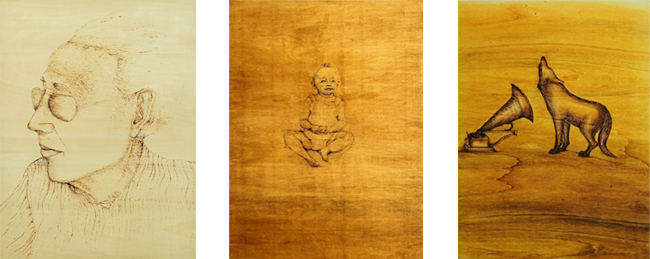שי עבאדי — ראדו
חמישי, 26.01.12 | שעה 20:00

אודות התערוכה
בתערוכה הנוכחית “ראדו” ממשיך שי עבאדי להתקוטט עם פנתיאון התרבות הישראלי בהציגו את ראדו קלפר. מי שהיה משורר, סופר, הומוסקסואל, מבקר תרבות וספרן בספרית המחול, לא זכה לתהילה בחייו או לזיכרון במותו וידוע אך למתי מעט. עבאדי טורח ומוציא את דמותו אל האור ובכך חושף ביוגרפיה של איש תרבות וגולה נצחי בישראל. בשימו את ראדו הנשכח במרכז הפריים קורא עבאדי תיגר על תרבות הכאן והעכשיו, על השכחה ורדידות המחשבה ומחזיר את ההילה לראוי לה.
בספרו “יהודים בעל כורחם”, מצטט ראדו קלפר את לידיה פלם: “עם זיגמונד פרויד הבנתי שהפראות היא אנושית והתרבות היא משימה בלא סוף, שאינה נגמרת לעולם, כמו האהבה או הכתיבה”. עבאדי ממשיך את המשימה באמנות הפלסטית כמו נענה לציווי שהועבר אליו מראדו. על לוחות עץ מסוגים שונים בגודל אחיד (90X120ס”מ) הוא צורב מעגל חיים של אדם. כל סוג עץ משמש מצע לתקופה אחרת בחייו, וכך תכונות העץ של הלבנה, הצפצפה או הדיקט יוצרות דיאלוג בין הרקע והתפאורה לדימוי התינוק, הנער, האיש הצעיר והמבוגר התשוש.
טכניקת השריפה על גבי הלוחות עוזרת לעבאדי למצות את תפיסתו אודות ההרס והבנייה. השריפה המכלה את החומר יוצרת את הדימוי. ככל שהוא שורף יותר כך הוא מעמיק בפרטי הקמט, הצחוק והסרקזם, מצב הרוח ושאר הרוח של הדמות, שבחייה היה בה גם יסוד טוטאלי והרסני. הטכניקה מאפשרת לעבאדי להפוך את ספור החיים של ראדו למשל. ככל שהדמות מתבגרת היא הופכת רוחנית יותר. דמות הילד החדה המחייכת לבדה במרכז הפריים במלואה דוהה לאיטה עם חלוף השנים. בהתבגרותה היא מתמצתת לראש, הקווים השרופים מתפוגגים לתוך העץ כך שקצות שערותיה משתלבות במצע, מרחפות בחלל ללא גוף.
בנוסף לביוגרפיה המצטיירת בעבודות, צורב עבאדי ציטוטים משיריו של ראדו כמו להטמין בעץ את מה שלא נקרא בספריו של האיש. מילות השירים הן חלק בלתי נפרד מהדימוי: הן סוודר, הן כתם בנוף והן מעצבות את ראדו כבמעין מדליה – מצביא תרבותי הנשמר לנצח.
את הסדרה חותם ציור שמן אחד: פורטרט רהוט, מדויק וקלאסי של אדם שכמו קיבל את המקום הראוי לו. בכך, פורע עבאדי את ההבטחה לזכור את מורו הרוחני וידיד נפשו.
נעילת התערוכה: 02.03.2012
Shy Abady — Radu
Thursday 26.01.12 | at 20:00
In his book “Unwilling Jews”, Radu Klapper quotes Lydia Flem: “With Sigmund Freud I realized that savagery is human and that culture is a boundless mission, never ending, like love or writing”. Abady carries on this mission in his art, as if responding to an edict bestowed upon him by Radu. He burns the life cycle of an individual on uniform panels (120X90cm.) made of various types of woods. Each type of wood captures a distinct period in life. Thus, the qualities of the birch, poplar and plywood establish a dialogue with the images of the baby, the adolescent, the young man and the worn-out senior.
Abady’s wood-burning technique captures the two moments of destruction and construction. The torching, which annihilates the material substance, creates the image. The more he burns, the deeper he delves into the details: the wrinkle, laughter and sarcasm, the moods, and the aspirations of an individual who also has a totalizing and destructive side. The technique enables Abady to turn Radu’s life story into a metaphor. The older the image gets the more spiritual it becomes. The full, sharp image of a smiling child in the center of the frame slowly fades as years go by. As it matures the image is condensed into a head, the burning lines fading into the wood so that its hair merges into the surface, and floats without a body in space.
In addition to the painted biography, Abady etches quotes from Radu’s poems, as if planting into the wood words which were not read in his printed books. The lyrics are inseparable from the image: they form a sweater, a mark in the landscape, and they shape Radu as a medal – as an immortal cultural hero.
The series concludes with a single oil painting: an eloquent portrait, precise and classical, of a man who finally received his well-deserved status. Thus Abady fulfills his promise to remember his spiritual teacher and soul mate.
Closing: 02.03.12
